A Study on the Development of the Stainless Steel Tube Bundle Structure Detecting System Using Ultrasonic Guided Wave
Abstract
1. Introduction
2. Transducer and Specimen Fabrication
3. Ultrasonic Guided Wave in Tube-like Structure
4. Experiment and Results
4.1. Experiment Setup
4.2. Experiment Results
5. Discussions
6. Conclusions
Author Contributions
Funding
Data Availability Statement
Acknowledgments
Conflicts of Interest
References
- Barshinger, J.; Rose, J.L.; Avioli, M.J., Jr. Guided wave resonance tuning for pipe inspection. J. Pressure Vessel Technol. 2002, 124, 303–310. [Google Scholar] [CrossRef]
- Rose, J.L. A baseline and vision of ultrasonic guided wave inspection potential. J. Pressure Vessel Technol. 2002, 124, 273–282. [Google Scholar] [CrossRef]
- Rose, J.L.; Sun, Z.; Mudge, P.J.; Avioli, M.J. Guided wave flexural mode tuning cand focusing for pipe testing. Mater. Eval. 2003, 61, 162–167. [Google Scholar]
- Van Velsor, J.K.; Royer, R.L.; Owens, S.E.; Rose, J.L. A magnetostrictive phased array system for guided wave testing and structural health monitoring of pipe. Mater. Eval. 2013, 71, 11. [Google Scholar]
- Rose, J.L. Guided wave studies for enhanced acoustic emission inspection. Res. Nondestruct. Eval. 2021, 32, 192–209. [Google Scholar] [CrossRef]
- Thomas, R.H.; Joseph, L.R. Flexible PVDF comb transducers for excitation of axisymmetric guided waves in tube. Sens. Actuators A 2002, 100, 18–23. [Google Scholar]
- Bray, A.V.; Corley, C.J.; Fischer, R.B.; Rose, J.L.; Quarry, M.J. Development of guided wave ultrasonic techniques for detection of corrosion under insulation in metal pipe. In Proceedings of the 1998 ASME Energy Sources Technology Conference, Houston, TX, USA, 12 January 1998; p. 1170. [Google Scholar]
- Lee, D.H.; Cho, H.J.; Kang, T.; Park, D.J.; Kim, B.D.; Huh, Y.S.; Lee, Y.J. A Study on the Optimum Generation Condition of ultrasonic Guided waves for Insulation Tube lines. J. Korean Inst. Gas 2016, 20, 50–57. [Google Scholar] [CrossRef][Green Version]
- Park, J.; Lee, J.; Jeong, S.-G.; Cho, Y. A study on guided wave propagation in a long distance curved tube. J. Mech. Sci. Technol. 2019, 33, 4111–4117. [Google Scholar] [CrossRef]
- Park, M.S.; Lee, J.S.; Ha, J.M.; Seung, H.M.; Ma, P.S. Development of an Electromagnetic Acoutic Transdecer Generating Circumferential Guided Waves for Defect Detection of Water Supply Tubes. J. Korean Soc. Nondestruct. Test. 2020, 40, 206–214. [Google Scholar] [CrossRef]
- Maciej, W. Structural Integrity of Steel Pipeline with Clusters of Corrosion Defects. Materials 2021, 14, 852. [Google Scholar] [CrossRef]
- Hwang, K.C.; Chen, Y.F. Development of a guided wave based ultrasonic inspection system for detecting broken tubes in stainless steel tube bundles. Meas. Sci. Technol. 2011, 22, 035401. [Google Scholar]
- Watanabe, T.; Nakamura, Y.; Murakami, K.; Maeda, Y.; Saito, S. Development of ultrasonic guided wave inspection system for detection of corrosion/erosion damage in nuclear power plant tubes. NDT&E Int. 2010, 43, 74–80. [Google Scholar]
- Li, L.; Li, C.; Li, W.; Chen, L. Guided wave testing for the inspection of tubes in heat exchangers. Insight-Non-Destr. Test. Cond. Monitoring 2013, 55, 344–350. [Google Scholar]
- Su, Y.; Fan, B.; Huang, Y.; Wang, Y.; Liu, J. Development and application of ultrasonic guided wave testing for detecting defects in tubes. J. Nondestruct. Eval. 2013, 32, 1. [Google Scholar]
- Song, K.; Kim, H. Development of a guided wave inspection system using piezoelectric transducers for the detection of broken tubes in heat exchangers. Meas. Sci. Technol. 2012, 23, 095401. [Google Scholar]
- Li, W.; Deng, M.; Cho, Y. Cumulative second harmonic generation of ultrasonic guided waves propagation in tube-like structure. J. Comput. Acoust. 2016, 24, 1650011. [Google Scholar] [CrossRef]
- Rostami, J.; Tse, P.W.; Fang, Z. Sparse and dispersion-based matching pursuit for minimizing the dispersion effect occurring when using guided wave for pipe inspection. Materials 2017, 10, 622. [Google Scholar] [CrossRef]
- Rose, J.L.; Philtron, J.; Liu, G.; Zhu, Y.; Han, M. A hybrid ultrasonic guided wave-fiber optic system for flaw detection in pipe. Appl. Sci. 2018, 8, 727. [Google Scholar] [CrossRef]
- Li, W.; Lan, Z.; Hu, N.; Deng, M. Modeling and simulation of backward combined harmonic generation induced by one-way mixing of longitudinal ultrasonic guided waves in a circular pipe. Ultrasonics 2021, 113, 106356. [Google Scholar] [CrossRef]
- Kim, J.; Park, J.; Zhu, B.; Cho, Y. Nonlinear Ultrasonic Guided Wave Method Using Semi-Analytical Finite Element (SAFE) Technique on a Damaged SWO-V Spring Coil. Metals 2021, 11, 752. [Google Scholar] [CrossRef]
- Xu, J.; Chen, G.; Xu, J.; Zhang, Q. Guided Wave Transducer for the Locating Defect of the Steel Pipe Based on the Weidemann Effect. Actuators 2021, 10, 333. [Google Scholar] [CrossRef]
- Heesch, M.; Dziendzikowski, M.; Mendrok, K.; Dworakowski, Z. Diagnostic-Quality Guided Wave Signals Synthesized Using Generative Adversarial Neural Networks. Sensors 2022, 22, 3848. [Google Scholar] [CrossRef] [PubMed]
- Na, W.B.; Kundu, T. Underwater pipeline inspection using guided waves. J. Pressure Vessel Technol. 2002, 124, 196–200. [Google Scholar] [CrossRef]
- Vasiljevic, M.; Kundu, T.; Grill, W.; Twerdowski, E. Pipe wall damage detection by electromagnetic acoustic transducer generated guided waves in absence of defect signals. J. Acoust. Soc. Am. 2008, 123, 2591–2597. [Google Scholar] [CrossRef]
- Sharma, S.; Mukherjee, A. Ultrasonic guided waves for monitoring corrosion in submerged plates. Struct. Control. Health Monit. 2015, 22, 19–35. [Google Scholar] [CrossRef]
- Zhu, J.; Ho, S.C.M.; Patil, D.; Wang, N.; Hirsch, R.; Song, G. Underwater pipeline impact localization using piezoceramic transducers. Smart Mater. Struct. 2017, 26, 107002. [Google Scholar] [CrossRef]
- Abbas, M.; Shafiee, M. Structural health monitoring (SHM) and determination of surface defects in large metallic structures using ultrasonic guided waves. Sensors 2018, 18, 3958. [Google Scholar] [CrossRef]
- Auger, F.; Flandrin, P. Improving the Readability of Time-Frequency and Time-Scale Representations by the Reassignment Method. IEEE Trans. Signal Process. 1995, 43, 1068–1089. [Google Scholar] [CrossRef]
- Cerniglia, D.; Pantano, A.; Montinaro, N. 3D Simulations and Experiments of Guided Wave Propagation in Adhesively Bonded Multi-Layered Structures. NDT&E Int. 2010, 43, 527–535. [Google Scholar]
- Gazis, D.C. Three-dimensional investigation of the propagation of waves in hollow circular cylinders. 1. Analytical foundation. J. Acoust. Soc. Am. 1959, 31, 568–573. [Google Scholar] [CrossRef]
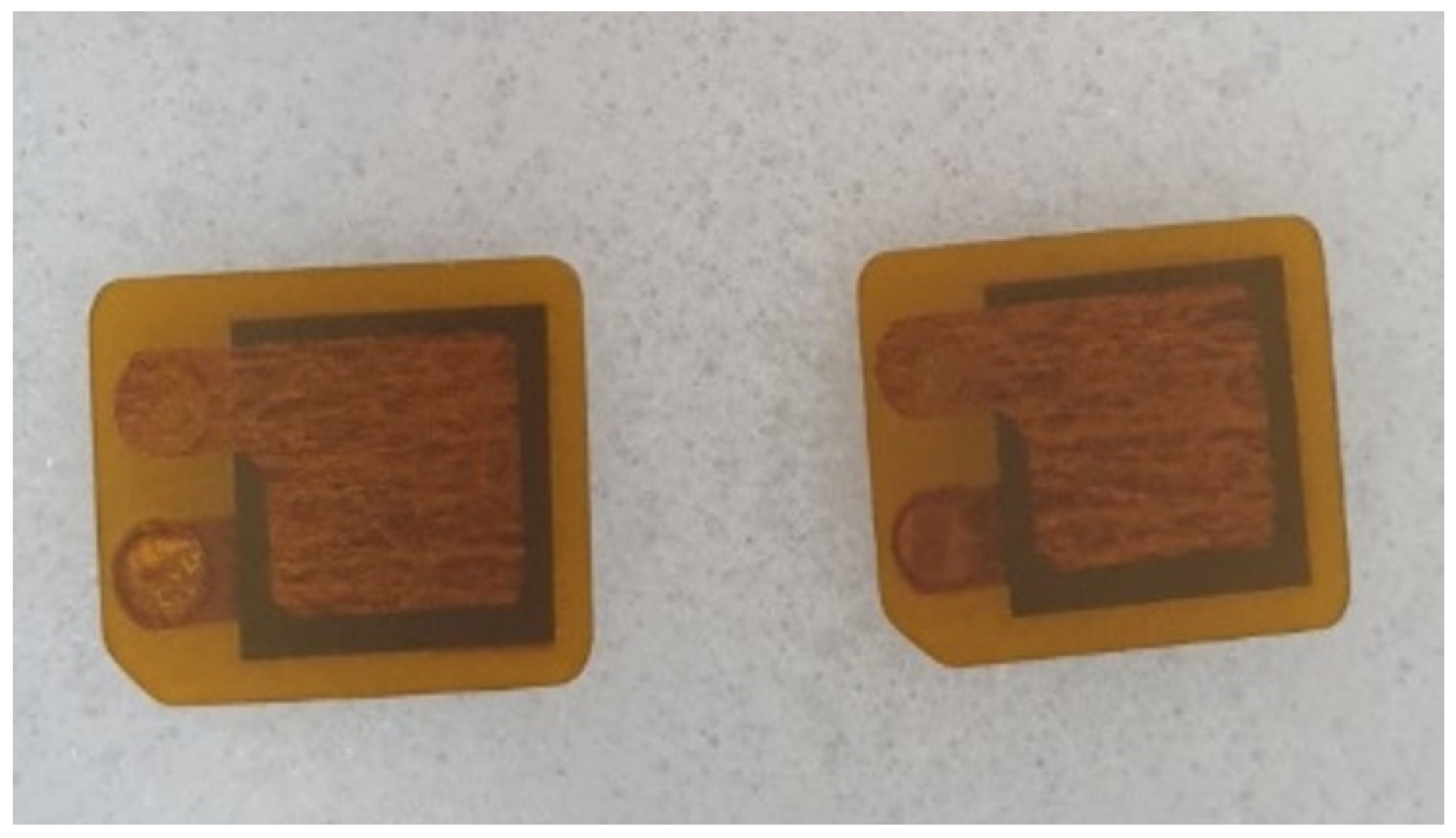

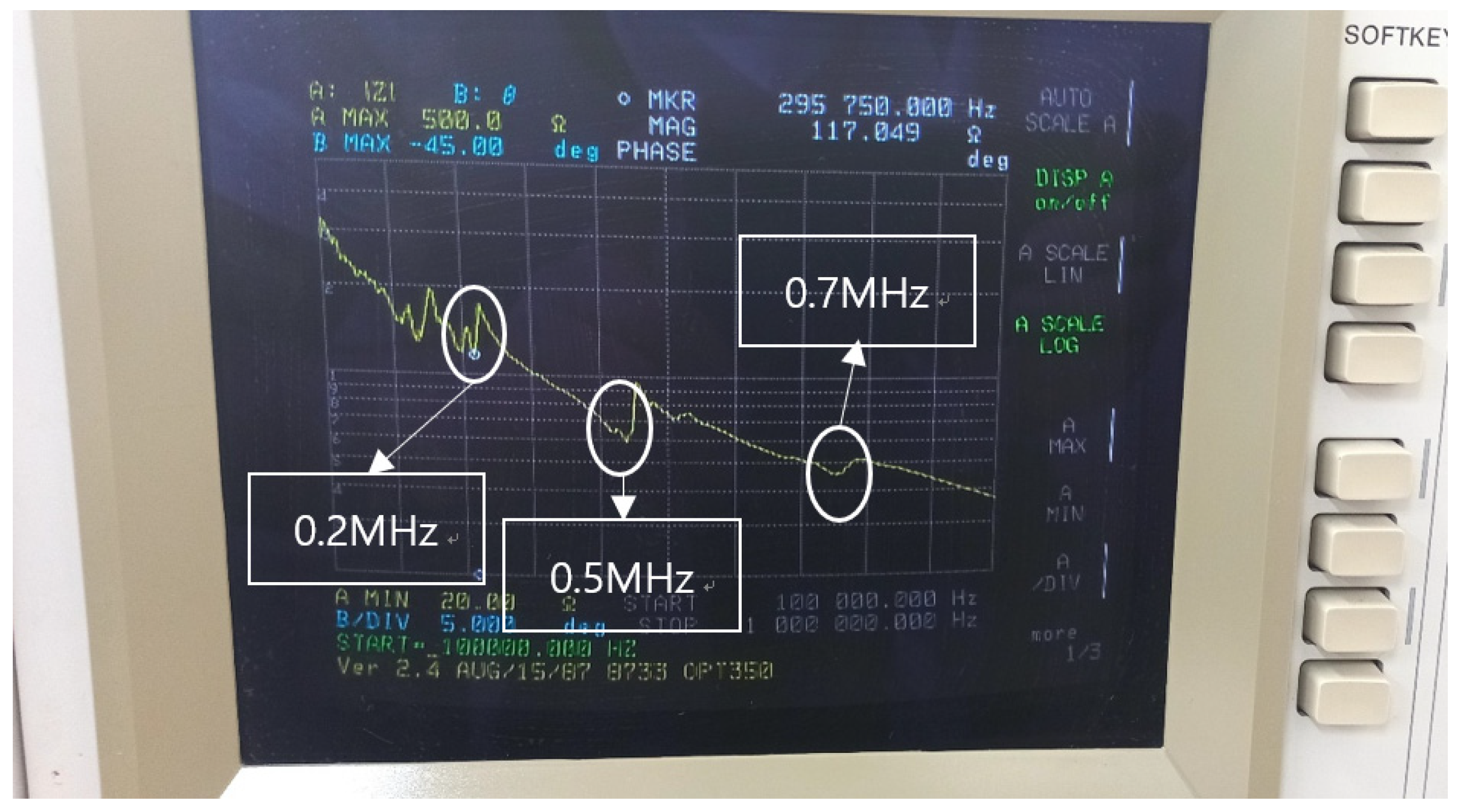
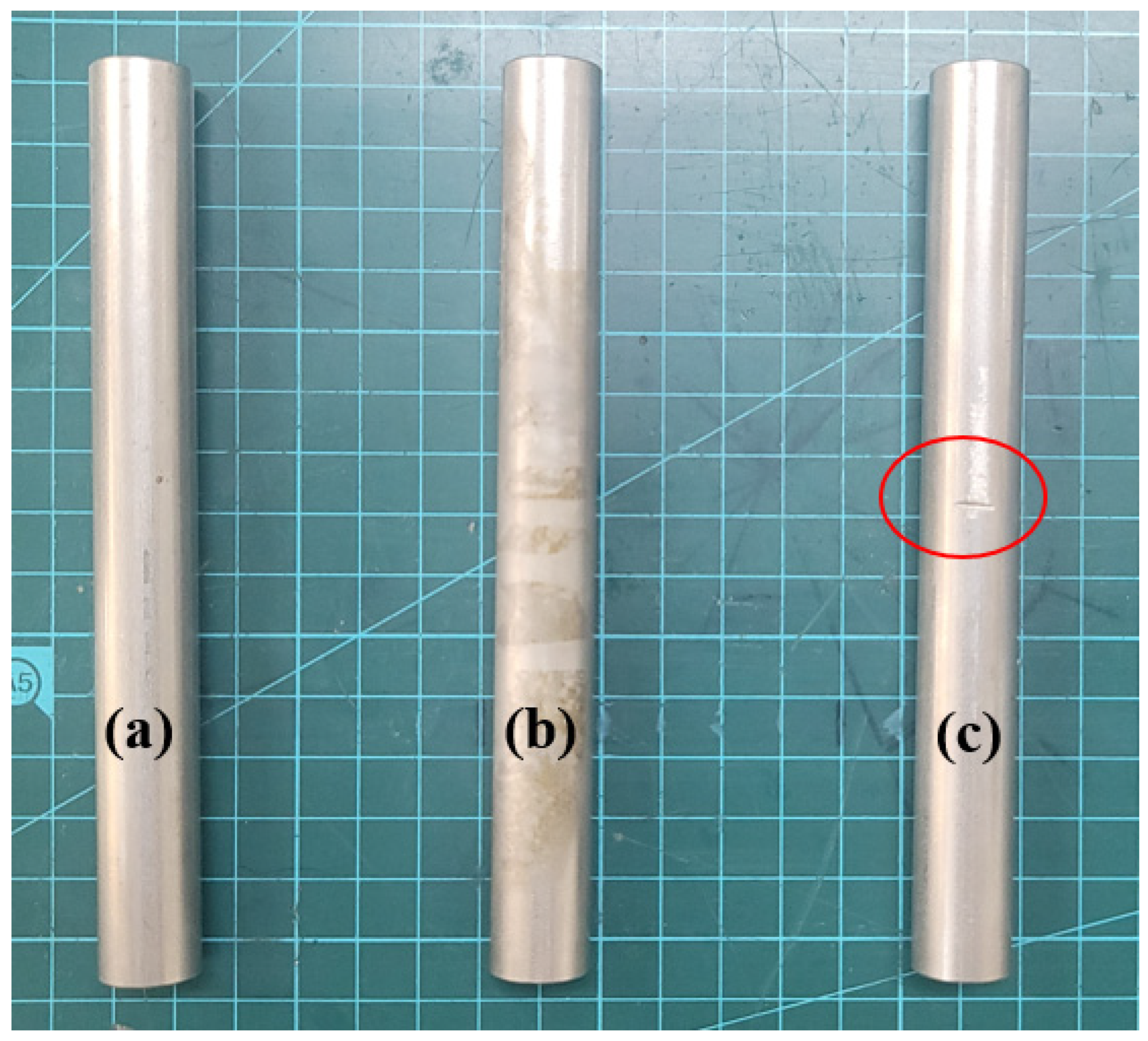
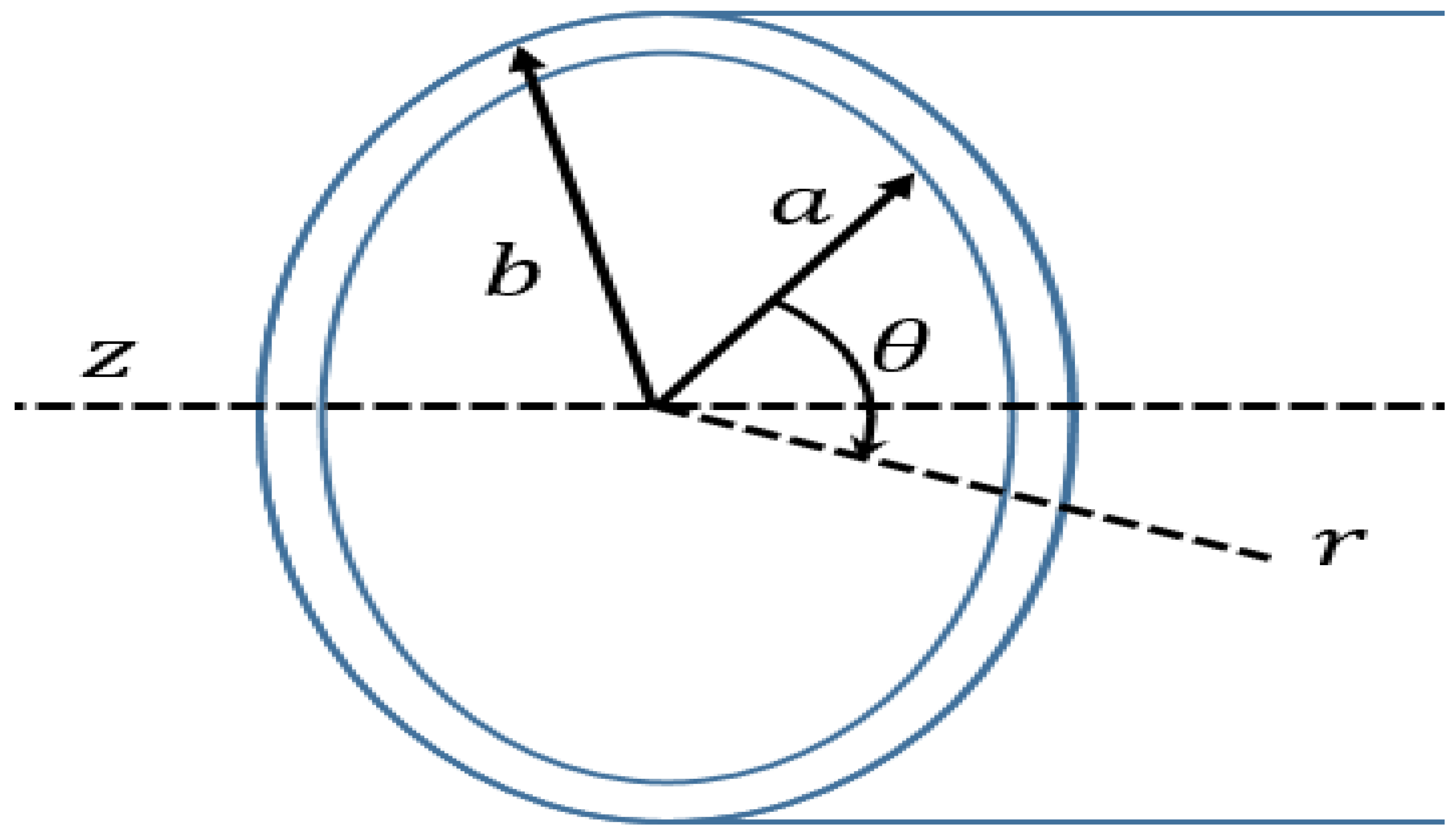


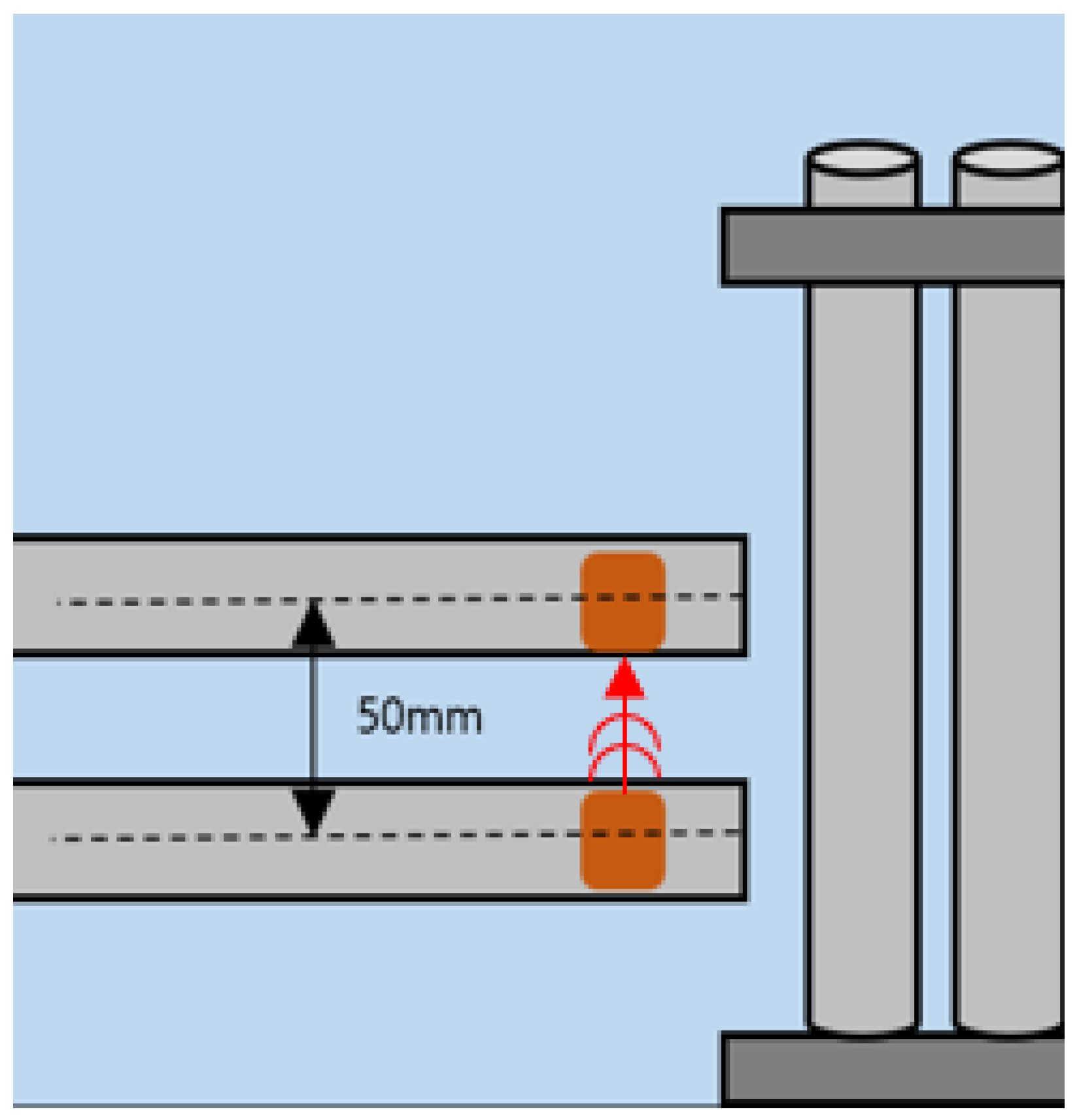

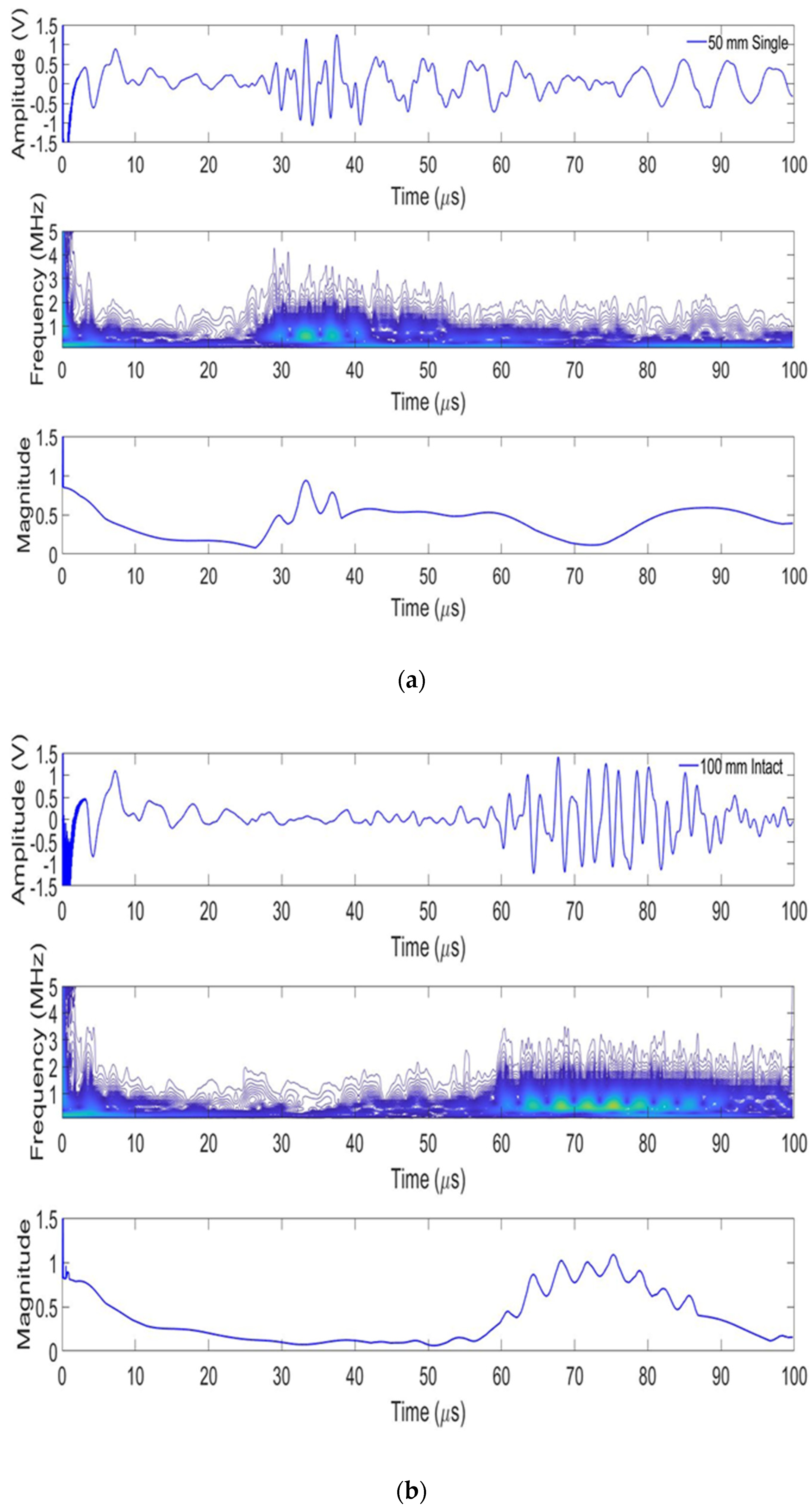
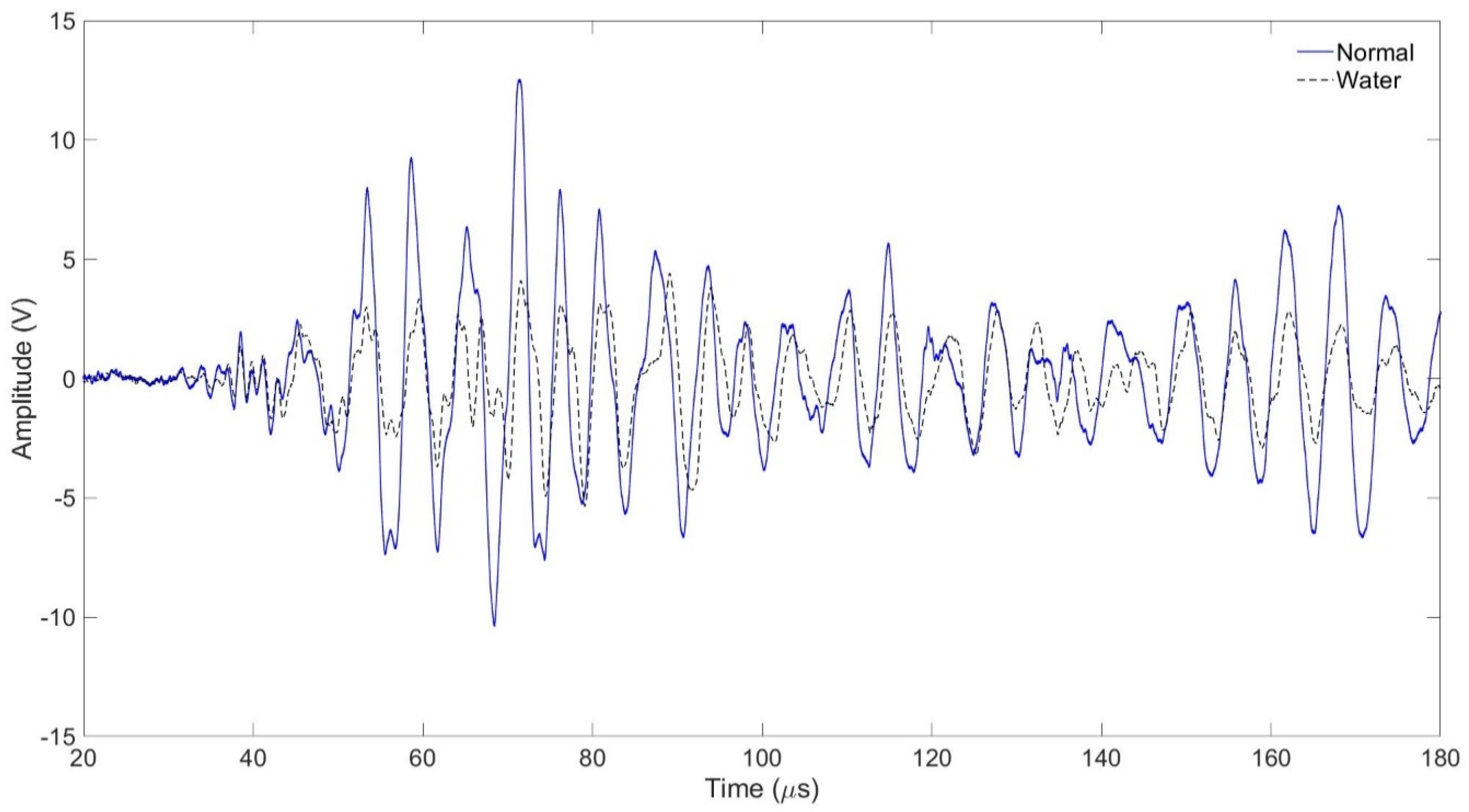


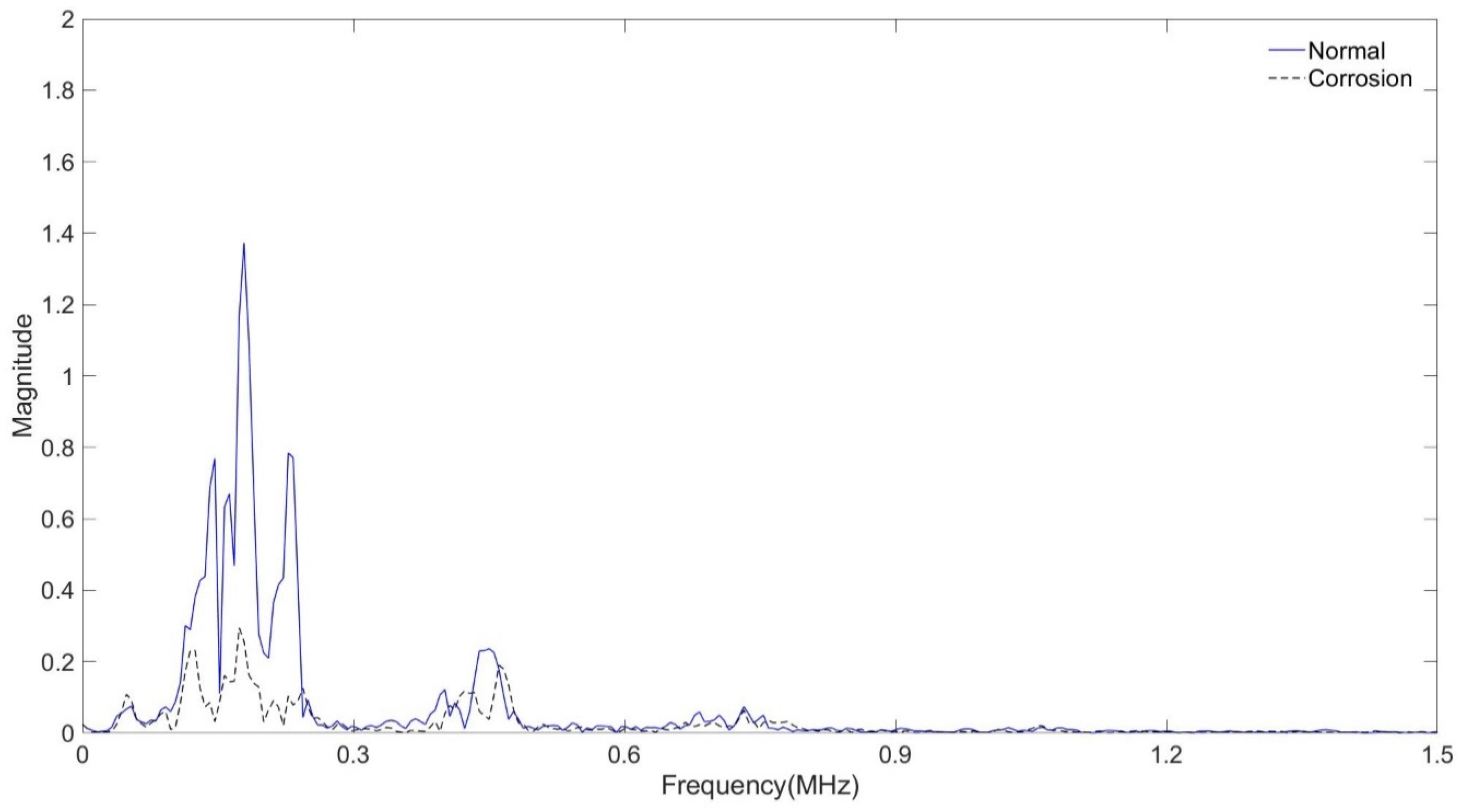
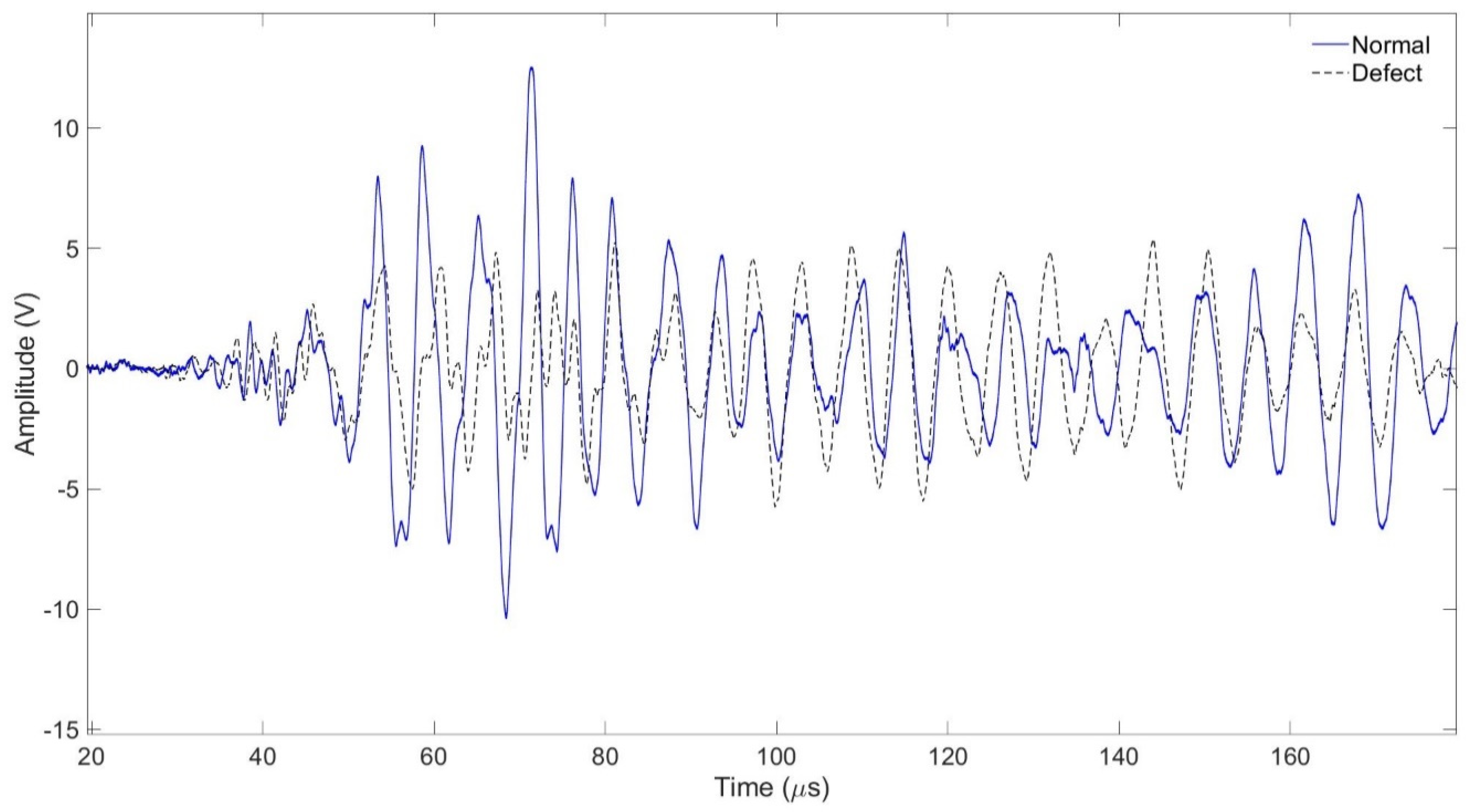
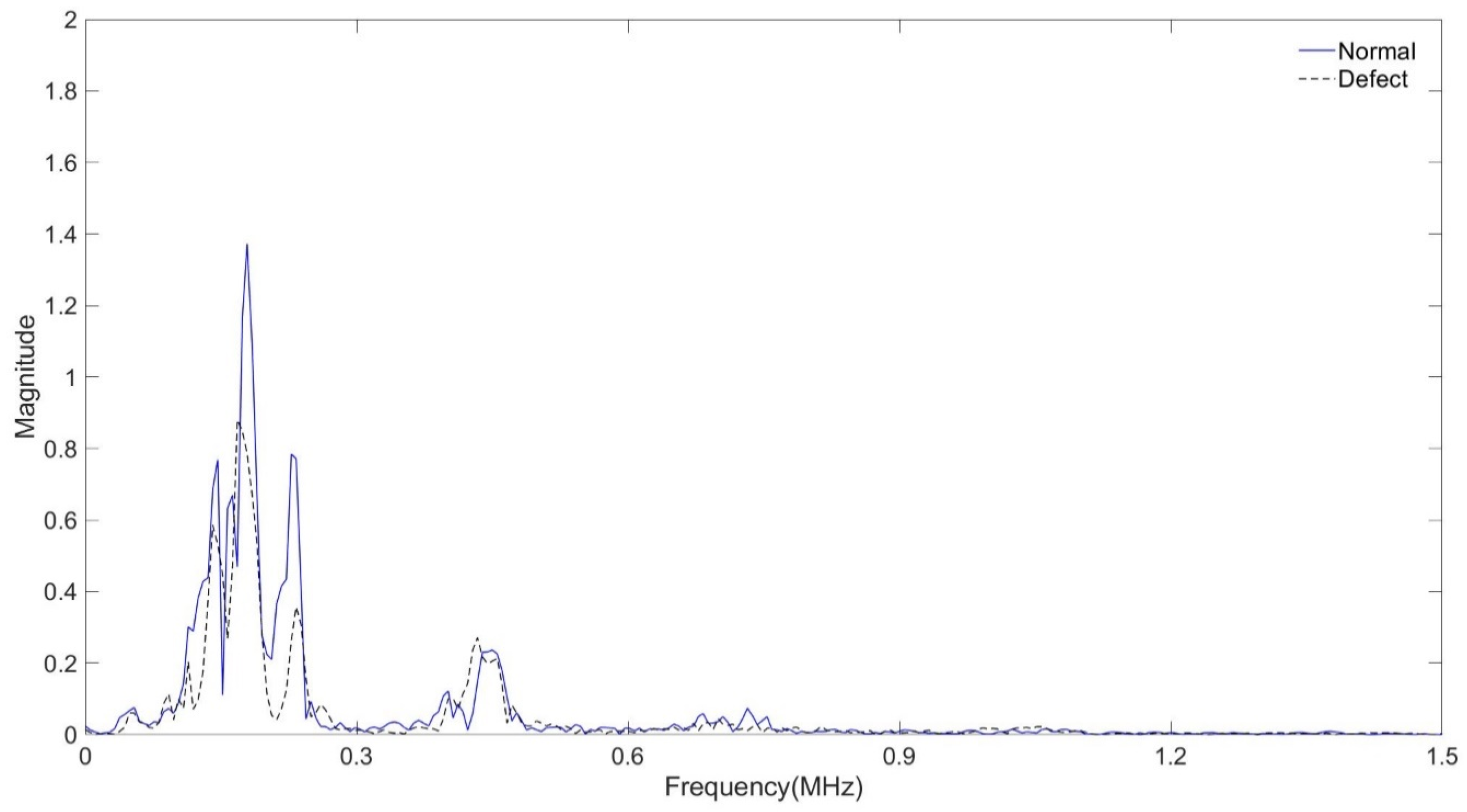
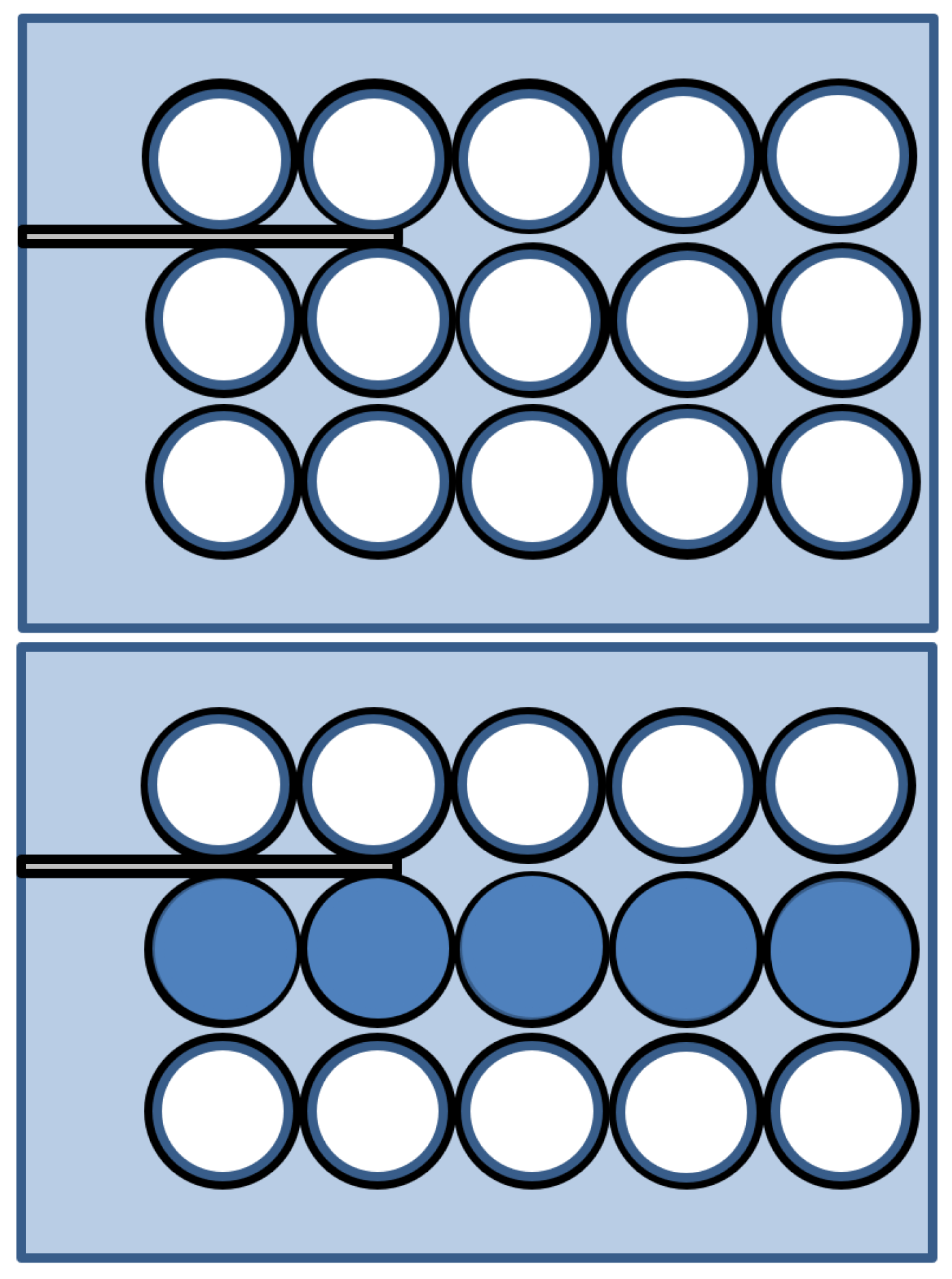
| No. 1 | No. 2 | No. 3 | No. 4 | No. 5 | |
|---|---|---|---|---|---|
| Magnitude of normal tube at 0.2 MHz | 0.007131 | 0.008468 | 0.007604 | 0.001378 | 0.01448 |
| Magnitude of tube filled with water at 0.2 MHz | 0.004572 | 0.003757 | 0.005047 | 0.007313 | 0.008324 |
| Amplitude ratio | 64.1% | 44.4% | 66.7% | 53.1% | 57.5% |
Disclaimer/Publisher’s Note: The statements, opinions and data contained in all publications are solely those of the individual author(s) and contributor(s) and not of MDPI and/or the editor(s). MDPI and/or the editor(s) disclaim responsibility for any injury to people or property resulting from any ideas, methods, instructions or products referred to in the content. |
© 2024 by the authors. Licensee MDPI, Basel, Switzerland. This article is an open access article distributed under the terms and conditions of the Creative Commons Attribution (CC BY) license (https://creativecommons.org/licenses/by/4.0/).
Share and Cite
Kim, J.; Zhang, J.; Malikov, A.K.u.; Cho, Y. A Study on the Development of the Stainless Steel Tube Bundle Structure Detecting System Using Ultrasonic Guided Wave. Sensors 2024, 24, 5278. https://doi.org/10.3390/s24165278
Kim J, Zhang J, Malikov AKu, Cho Y. A Study on the Development of the Stainless Steel Tube Bundle Structure Detecting System Using Ultrasonic Guided Wave. Sensors. 2024; 24(16):5278. https://doi.org/10.3390/s24165278
Chicago/Turabian StyleKim, Jeongnam, Jiannan Zhang, Azamatjon Kakhramon ugli Malikov, and Younho Cho. 2024. "A Study on the Development of the Stainless Steel Tube Bundle Structure Detecting System Using Ultrasonic Guided Wave" Sensors 24, no. 16: 5278. https://doi.org/10.3390/s24165278
APA StyleKim, J., Zhang, J., Malikov, A. K. u., & Cho, Y. (2024). A Study on the Development of the Stainless Steel Tube Bundle Structure Detecting System Using Ultrasonic Guided Wave. Sensors, 24(16), 5278. https://doi.org/10.3390/s24165278










